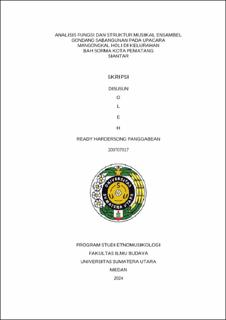| dc.contributor.advisor | Rithaony | |
| dc.contributor.advisor | Gulo, Hubari | |
| dc.contributor.author | Panggabean, Ready Hardersong | |
| dc.date.accessioned | 2025-02-11T06:50:41Z | |
| dc.date.available | 2025-02-11T06:50:41Z | |
| dc.date.issued | 2024 | |
| dc.identifier.uri | https://repositori.usu.ac.id/handle/123456789/101096 | |
| dc.description.abstract | This study discusses the Analysis of the Function and Structure of the Gondang Sabangunan Ensemble Musical at the Mangongkal Holi Ceremony in Bah Sorma Regency, Pematang Siantar City. The purpose of the study is to describe the function and musical structure of the Gondang Sabangunan ensemble presented at the Mangongkal Holi ceremony in Bah Sorma Village, Pematang Siantar City. The research method used is a qualitative research method with an observation approach, interviews, documentation, and laboratory work. In analyzing the Gondang Sabangunan ensemble at the Mangongkal Holi ceremony, the theory of uses and function pioneered by Alan P. Merriam was used. To analyze the musical structure of the Gondang Sabangunan ensemble, the weightscale theory pioneered by William P. Malm was used. In discussing the implementation of the Mangongkal Holi ceremony from the first day to the last day, the theory of the implementation of the ceremony from Koentjaraningrat was used. The results of this study revealed that the implementation of the Mangongkal Holi ceremony was carried out in accordance with the procedures that had been implemented by the hasuhuton (event organizer). The functions of the Gondang Sabangunan ensemble in the Mangongkal Holi ceremony ritual are: 1) Communication Function (2) Function of Ratification of Social Institutions and Religious Ceremonies (3) Function of Emotional Expression (4) Function of Cultural Sustainability (5) Function of Physical Reaction (6) Function of Symbolism (7) Function Related to Social Norms. In the musical structure of the Gondang Sabangunan ensemble, there are five types of gondang repertoire that are played with different compositions and meters so that they experience tempo changes from 150MM to 100MM tempo with the meter used is meter 4 isometric (same/unchanged from the beginning to the end of the repertoire).
Keywords: Mangongkal Holi, Gondang, Function, and Musical Structure | en_US |
| dc.language.iso | id | en_US |
| dc.publisher | Universitas Sumatera Utara | en_US |
| dc.subject | Mangongkal Holi | en_US |
| dc.subject | Gondang | en_US |
| dc.subject | Function | en_US |
| dc.subject | Musical Structure | en_US |
| dc.title | Analisis Fungsi dan Struktur Musikal Ensambel Gondang Sabangunan pada Upacara Mangongkal Holi di Kelurahan Bah Sorma Kota Pematang Siantar | en_US |
| dc.title.alternative | Analysis of the Function and Structure of the Gondang Sabangunan Ensemble Musical at the Mangongkal Holi Ceremony in Bah Sorma Village, Pematang Siantar City | en_US |
| dc.type | Thesis | en_US |
| dc.identifier.nim | NIM200707017 | |
| dc.identifier.nidn | NIDN0016116305 | |
| dc.identifier.nidn | NIDN0021067203 | |
| dc.identifier.kodeprodi | KODEPRODI91201#Etnomusikologi | |
| dc.description.pages | 138 Pages | en_US |
| dc.description.type | Skripsi Sarjana | en_US |
| dc.subject.sdgs | SDGs 4. Quality Education | en_US |


